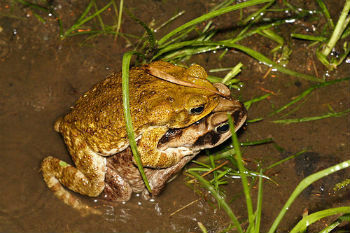Frogs are small amphibian animals belonging to the Order Anura.
The order of Anurans includes over 5000 species of toads, frogs and tree frogs. Frogs belong to the Bufonidae family, with about 454 species. In Brazil, most species are found in the Atlantic Forest and the Amazon.
The life of frogs is closely related to water. Water is essential for its reproduction and humidity guarantees skin respiration.
O Owl marinus (cane toad) is the most common species in Brazil.

Owl marinus
Learn more about amphibians.
Body Cover
The skin of frogs is dry, glandular and vascularized. They do not have any type of hair or scales.
Thin skin allows gas exchange, skin respiration. This condition also requires frogs to inhabit damp, shady environments. Exposure to sunlight can cause the skin to dry out. Therefore, many frogs are only active at night.
The color of frogs can be similar to where they live, which is important for their defense. Other species can be colored, being quite attractive.
The skin of frogs also contains chemical substances that act in defense against predators, fungi and bacteria.
Habitat
Frogs can be found all over the world, except in very cold places.
In general, frogs inhabit humid places, such as near streams, lakes, streams and swamps. That's because their way of life is strongly related to water.
Breathing
Frogs have two life stages:
The larval stage, in an aquatic environment, when they perform the gill breathing. And the adult stage, in a terrestrial environment, when they perform the lung breathing and the skin breathing.
food
Frogs feed on spiders, beetles, grasshoppers, flies, ants and termites. Some larger species can eat small birds and even other frogs.
The frog captures its prey through its tongue, which is very agile and extensible. The tongue is still sticky and causes the food to stick together until it is taken into the mouth.
A curious fact is that the frog closes its eyes to swallow food. That's because the large eyes are forced into the mouth cavity and help push food down the throat.
reproduction
Toad reproduction begins when males coach (sing) to attract females. In some species, the female chooses the male with the strongest singing. The singing guides the female to the meeting with her partner. Generally, the male sings close to watery environments necessary for reproduction.
When they are together, the male embraces the female, an act called hugging, and the gametes are released into the water. In this case, the frogs carry out external fertilization.
Learn more about Internal and External Fertilization.

Attachment at the time of reproduction
After a while, the eggs release the tadpoles (larval stage), which undergo metamorphosis and transform into miniature adults, reaching the terrestrial environment. The metamorphosis time varies from species to species, it can take from days to months.
The main feature of the frog metamorphosis is the loss of the tadpole's tail, which turns into legs. This condition allowed the advancement to the terrestrial environment and was an important evolutionary achievement.
Learn more about Animal Metamorphosis.
poisonous toads
Some species of frogs are poisonous. Learn about some of these species:
- Dendrobates leucomella: Species found among trees and rocks. The poison is located under your skin.
- Phyllomedusa bicolor: Very poisonous species, found in the Amazon. In humans, the venom can cause tachycardia, vomiting and diarrhea.
- Phyllobates terribilis: One of the most poisonous frogs in the world, despite being only 5 cm. Found in Colombia.
- Bicolor Phyllobates: Native of Colombia. Its poison was once responsible for the death of humans.
Curiosities
- An adult frog ingests approximately the equivalent of 3 cups full of flies a day.
- The songs of frogs and frogs are genetically inherited from one generation to another, and do not require learning.
- Because frogs produce chemicals in their skin that protect them against bacteria and fungi, there is less chance of getting a disease when we touch a frog, than when we touch dogs or cats, by example.
